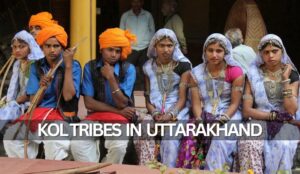Joshimath, a quaint town nestled in the Garhwal Himalayas of Uttarakhand, India, is a place where spirituality meets stunning natural beauty. From its historic significance to the breathtaking landscapes that surround it, Joshimath has become a sought-after destination for both religious pilgrims and nature enthusiasts alike.
Introduction
Nestled at an elevation of 1,890 meters above sea level, Joshimath, also known as Jyotirmath, is a place where spirituality, history, and nature intertwine seamlessly. Its serene atmosphere and captivating vistas make it an ideal destination for those seeking solace in the lap of the Himalayas.
History and Significance
Joshimath, also known as Jyotirmath, is a town situated in the Chamoli district of Uttarakhand, India. It holds immense historical and religious significance due to its connections to Hindu mythology, spirituality, and pilgrimage. Here are the detailed points highlighting its history and significance:
1. Mythological Connections:
- Joshimath is believed to be one of the four “mathas” (monastic establishments) established by Adi Shankaracharya, a revered Hindu philosopher, and theologian, in the 8th century CE.
- According to mythology, Adi Shankaracharya meditated in Joshimath before moving to Badrinath, another important pilgrimage site.
2. Gateway to Badrinath:
- Joshimath serves as a base for pilgrims visiting the revered Badrinath Temple, dedicated to Lord Vishnu, which is one of the Char Dham pilgrimage sites in India.
- The temple at Badrinath is closed during the winter months, and Joshimath becomes the temporary seat of the deity during this period.
3. Adi Shankaracharya’s Influence:
- Adi Shankaracharya’s matha in Joshimath, known as Jyotirmath, has been a center of learning and spiritual guidance for centuries.
- It is said that Adi Shankaracharya attained enlightenment in this region, which enhances the town’s spiritual significance.
4. Trekking Hub:
- Joshimath serves as the starting point for various treks and expeditions into the Himalayas, including the popular Kuari Pass trek and the Valley of Flowers trek.
- Trekkers and adventure enthusiasts use Joshimath as a base camp to explore the breathtaking landscapes of the region.
5. Auli – Skiing Destination:
- Auli, a picturesque hill station located near Joshimath, is renowned for its skiing opportunities.
- Tourists visit Auli during the winter months to enjoy skiing on its well-maintained slopes and to experience the stunning snow-covered surroundings.
6. Connectivity and Pilgrimage Routes:
- Joshimath’s location at the confluence of rivers Alaknanda and Dhauliganga makes it an important stop on the route to various religious sites, including Badrinath, Hemkund Sahib, and Valley of Flowers.
- The town’s connectivity to these sites and its role as a transit point have contributed to its significance.
7. Natural Beauty:
- Joshimath is surrounded by breathtaking natural beauty, with majestic mountains, lush greenery, and serene rivers creating a tranquil atmosphere.
- The town’s setting in the Garhwal Himalayas makes it a sought-after destination for nature lovers and photographers.
8. Cultural and Spiritual Hub:
- The town’s ancient temples, including the Narsingh Temple and the Sankaracharya Temple, showcase the rich cultural and religious heritage of the region.
- The annual “Maha Aarti” ceremony held at the Narsingh Temple is a significant event that draws devotees and tourists alike.
How to Reach Joshimath
Joshimath, situated in the Himalayan region of Uttarakhand, India, is a gateway to various pilgrimage sites and trekking adventures. While reaching this picturesque town requires traversing challenging terrain, several transportation options are available to make your journey smoother.
1. By Air:
- The nearest airport to Joshimath is the Jolly Grant Airport in Dehradun, approximately 270 kilometers away.
- From the airport, you can hire a taxi or take a bus to reach Joshimath. The drive takes around 8 to 10 hours, depending on road conditions.
2. By Train:
- The nearest major railway station is Rishikesh, located about 250 kilometers from Joshimath.
- From Rishikesh, you can hire a taxi or take a bus to reach Joshimath. The road journey typically takes around 7 to 9 hours.
3. By Road:
- Joshimath is well-connected by road, and the journey offers breathtaking views of the Himalayan landscapes.
- You can take a private taxi or use public buses that run between major cities like Rishikesh, Haridwar, and Dehradun to Joshimath.
- The drive can be challenging due to narrow roads and steep inclines, so it’s advisable to hire an experienced driver if you’re not familiar with the terrain.
4. Shared Taxis and Buses:
- Shared taxis and buses are available from Rishikesh and Haridwar to Joshimath.
- Shared vehicles are more budget-friendly but might take longer due to multiple stops along the route.
5. Helicopter Services:
- During the pilgrimage season, helicopter services operate between Dehradun and Joshimath, providing a quicker and more comfortable option.
- Helicopter services are subject to weather conditions and availability, so it’s recommended to check in advance.
6. Trekking Routes:
- For adventurous trekkers, there are trekking routes that connect Joshimath to various destinations like the Valley of Flowers and Hemkund Sahib.
- These treks offer a unique way to experience the Himalayan beauty and can be a rewarding journey for nature enthusiasts.
Gateway to Spiritual Journeys
Nestled in the lap of the Himalayas, Joshimath emerges as a significant gateway to spiritual journeys and divine experiences. This town, situated in Uttarakhand, India, holds a unique position in the hearts of pilgrims, trekkers, and seekers of spiritual solace. Here’s why Joshimath is revered as a gateway to profound spiritual journeys:
1. Pilgrimage Center:
- Joshimath serves as a pivotal starting point for pilgrims embarking on journeys to revered shrines like Badrinath, Hemkund Sahib, and Valley of Flowers.
- The town’s strategic location and connectivity make it an essential stop for those seeking a deeper connection with their faith.
2. Adi Shankaracharya’s Legacy:
- Adi Shankaracharya, a revered Hindu philosopher, established one of his four “mathas” (spiritual centers) in Joshimath.
- This matha, named Jyotirmath, became a seat of spiritual learning, where seekers and scholars gathered to understand the essence of Vedanta and spirituality.
3. Meditative Atmosphere:
- Surrounded by the tranquil beauty of the Himalayan landscape, Joshimath offers an ideal environment for meditation and introspection.
- Seekers can immerse themselves in the serenity of nature, enhancing their spiritual experience.
4. Winter Abode of Deities:
- During the winter months, when the Badrinath Temple becomes inaccessible due to heavy snowfall, the deity is ceremoniously transferred to Joshimath’s Narsingh Temple.
- This tradition signifies Joshimath’s sacredness as it temporarily shelters the divine presence.
5. Sacred Confluence:
- The confluence of the Alaknanda and Dhauliganga rivers near Joshimath holds spiritual significance, creating an aura of sanctity.
- This natural meeting point symbolizes the blending of spiritual energies and is revered by pilgrims.
6. Inner Transformation:
- Many trekkers and travelers choose Joshimath as a base for transformative treks, such as the Kuari Pass trek or the journey to Hemkund Sahib.
- The challenging terrains mirror the inner struggles and growth that often accompany spiritual journeys.
7. Vibrant Festivals:
- The town comes alive with vibrant festivals, such as the “Maha Aarti” at the Narsingh Temple, where devotees gather to participate in rituals and celebrate their faith.
- These festivals foster a sense of community and provide a platform for spiritual rejuvenation.
8. Exploration of Self:
- As a hub for treks, Joshimath offers seekers a chance to venture into the Himalayas, facing both outer challenges and inner revelations.
- The rugged landscapes mirror the rugged paths of self-discovery.
Adventurous Escapades
For those seeking a thrilling dose of adventure amidst the majestic Himalayas, Joshimath and its surrounding areas offer a plethora of opportunities. From high-altitude treks to exciting outdoor activities, there’s no shortage of options for adventurous souls. Here’s a glimpse of the thrilling escapades you can embark upon:
1. Trekking Expeditions:
- Joshimath serves as a gateway to some of the most breathtaking trekking trails in the region.
- The Kuari Pass Trek, Valley of Flowers Trek, and Roopkund Trek are famous for their stunning landscapes and challenging terrains.
2. Skiing in Auli:
- Auli, a short distance from Joshimath, is a renowned skiing destination.
- During winter, the slopes of Auli transform into a haven for skiing enthusiasts, offering a thrilling experience against the backdrop of snow-covered peaks.
3. Paragliding and Cable Car Rides:
- Auli offers paragliding experiences that allow you to soar above the picturesque landscapes.
- The Auli Ropeway, one of the longest cable car rides in Asia, provides panoramic views of the mountains.
4. Camping Under the Stars:
- Camp in the lap of nature, surrounded by the Himalayan wilderness.
- Overnight camping offers a chance to connect with the outdoors, gaze at starlit skies, and bond with fellow adventurers.
5. Mountain Biking:
- The rugged terrains around Joshimath are perfect for mountain biking enthusiasts.
- Embark on thrilling rides that take you through challenging paths and offer a unique perspective of the landscapes.
6. Rock Climbing and Rappelling:
- Engage in rock climbing and rappelling activities that test your physical prowess and mental agility.
- Trained instructors and suitable locations ensure a safe and exciting experience.
7. Nature Walks and Birdwatching:
- Embark on leisurely nature walks to explore the lush surroundings.
- The region’s diverse flora and fauna make it a paradise for birdwatchers.
8. Horseback Riding:
- Explore the picturesque trails on horseback for a unique perspective of the landscape.
- Guided rides let you enjoy the beauty of the mountains while bonding with your equine companion.
Cultural Richness and Festivals
Joshimath, nestled in the lap of the Himalayas, is not only a natural haven but also a place rich in cultural heritage and vibrant festivals. The town’s cultural tapestry is interwoven with spiritual practices, traditional customs, and lively celebrations. Here’s a glimpse into the cultural richness and festivals that make Joshimath a unique destination:
1. Adi Shankaracharya’s Legacy:
- The town’s cultural heritage is deeply connected to Adi Shankaracharya, who established one of his four mathas (spiritual centers) in Joshimath.
- Adi Shankaracharya’s teachings continue to influence the spiritual practices and beliefs of the locals.
2. Narsingh Temple:
- The Narsingh Temple, dedicated to Lord Narasimha (an incarnation of Lord Vishnu), is a prominent religious site in Joshimath.
- The temple’s architecture and rituals reflect the rich cultural and religious traditions of the region.
3. Maha Aarti:
- The Narsingh Temple hosts a grand “Maha Aarti” ceremony that attracts devotees and tourists alike.
- This ritualistic celebration is a captivating experience, where lamps are lit, chants are recited, and offerings are made to the deity.
4. Festivals:
- Festivals in Joshimath are an integral part of the cultural fabric. They provide a platform for locals and visitors to come together in celebration.
- Makar Sankranti, celebrated in January, is marked by kite flying and traditional festivities.
- Narsingh Jayanti, dedicated to Lord Narasimha, is celebrated with great enthusiasm.
5. Pilgrimage Season:
- The pilgrimage season, typically from April to November, witnesses a surge of devotees visiting the Badrinath Temple and other nearby shrines.
- This period showcases the spiritual fervor and cultural exchange among people from diverse backgrounds.
6. Local Cuisine:
- The local cuisine of Joshimath offers a taste of the region’s culinary traditions.
- Savory dishes like aloo ke gutke (potato stir-fry) and sweets like bal mithai (a traditional dessert) are must-tries.
7. Handicrafts and Souvenirs:
- Explore the local markets for handicrafts, woolens, and souvenirs that reflect the region’s artistic craftsmanship.
8. Cultural Practices:
- Observing the daily lives of the locals, their rituals, and interactions provides insight into the cultural nuances of the region.
- Participating in local customs like lighting lamps and offering prayers can be a deeply enriching experience.
9. Music and Dance:
- Cultural performances during festivals often include traditional music and dance forms that depict the history and mythology of the area.
Exploring Nearby Attractions
1. Badrinath Temple:
- The iconic Badrinath Temple, dedicated to Lord Vishnu, is one of the Char Dham pilgrimage sites in India.
- Located around 44 kilometers from Joshimath, it’s a significant spiritual destination attracting devotees from across the world.
2. Auli:
- Auli, just 14 kilometers away, is a popular skiing destination known for its pristine slopes and panoramic mountain views.
- Visit during the winter for skiing adventures or in summer for trekking and enjoying the alpine beauty.
3. Valley of Flowers:
- A UNESCO World Heritage Site, the Valley of Flowers is a trekking paradise renowned for its vibrant alpine flowers during the monsoon.
- The trek to the valley begins from Govindghat, which is easily accessible from Joshimath.
4. Hemkund Sahib:
- Another revered pilgrimage site, Hemkund Sahib is a Sikh shrine situated near a glacial lake.
- It’s a challenging trek from Joshimath but rewards you with a spiritually uplifting experience and stunning natural beauty.
- This national park, a UNESCO World Heritage Site, is a haven for biodiversity and nature enthusiasts.
- It offers a chance to spot rare flora and fauna against the backdrop of the majestic Nanda Devi peak.
6. Bhavishya Badri:
- Among the Panch Badri temples, Bhavishya Badri is a lesser-known shrine, reachable by a trek.
- The trek leads you through scenic landscapes and offers a glimpse into the spiritual heritage of the region.
7. Tapovan:
- Tapovan is known for its serene landscapes, nestled at the base of some of the highest peaks in the Garhwal Himalayas.
- It’s a popular meditation and yoga spot, offering a tranquil environment for introspection.
8. Kalpavriksha:
- Joshimath is home to a revered Kalpavriksha tree, believed to be one of the oldest trees in India.
- It’s considered a wish-fulfilling tree and holds immense significance in Hindu mythology.
9. Charan Paduka:
- Just a short trek from Joshimath, Charan Paduka is believed to have imprints of Lord Vishnu’s feet.
- The trek provides panoramic views of the town and the surrounding landscape.
Best Time to Visit
Choosing the right time to visit Joshimath is crucial to fully experience its natural beauty, spiritual aura, and outdoor activities. The town’s weather and accessibility vary throughout the year, so here’s a breakdown of the best times to plan your visit:
1. Summer (April to June):
- Summer is the most popular time to visit Joshimath due to its pleasant weather and accessibility.
- The temperature ranges from 15°C to 30°C, creating comfortable conditions for sightseeing, outdoor activities, and trekking.
- This is an ideal time to explore nearby attractions, indulge in spiritual experiences, and undertake Himalayan treks.
2. Monsoon (July to September):
- Monsoon brings heavy rainfall to Joshimath, making the region prone to landslides and road closures.
- While the lush landscapes can be appealing, the risk of travel disruptions and difficult trekking conditions make this season less advisable for visiting.
3. Autumn (October to November):
- Autumn is another excellent time to visit Joshimath, as the weather remains pleasant and the skies are usually clear.
- The temperature starts to drop, ranging from 10°C to 25°C, but this is compensated by the stunning views of the Himalayas and colorful foliage.
- Pilgrimage and trekking activities continue, making it a well-rounded time to explore the region.
4. Winter (December to March):
- Winter is a unique time to visit for those seeking a different experience, especially if you enjoy snow and solitude.
- The temperatures can plummet to sub-zero levels, and heavy snowfall can lead to road closures and limited accessibility.
- However, if you’re a skiing enthusiast, Auli (near Joshimath) offers fantastic skiing opportunities during this season.
Accommodation Options
Joshimath, nestled in the picturesque Himalayas, offers a range of accommodation options to cater to the diverse needs of visitors, including pilgrims, trekkers, and travelers seeking spiritual solace. Here’s a rundown of the accommodation choices available in this charming town:
1. Hotels and Resorts:
- Joshimath boasts a variety of hotels and resorts catering to different budget ranges.
- From budget lodgings with essential amenities to luxurious resorts offering stunning views of the surrounding mountains, you can find accommodation that suits your preferences.
2. Guesthouses and Lodges:
- Guesthouses and lodges provide a more intimate and local experience.
- These options offer comfortable rooms and basic facilities, making them ideal for travelers looking for affordable and cozy stays.
3. Dharamshalas and Ashrams:
- For pilgrims seeking a spiritual experience, many dharamshalas (guesthouses associated with temples) and ashrams offer simple accommodations.
- Staying in these places often provides an opportunity to engage in spiritual practices and connect with like-minded individuals.
4. Homestays:
- Homestays provide a chance to experience the local culture and hospitality firsthand.
- You can stay with local families, enjoy home-cooked meals, and gain insights into the daily lives of the people of Joshimath.
5. Auli Accommodation:
- Auli, a skiing destination near Joshimath, offers accommodations ranging from ski resorts to lodges.
- If you’re interested in winter sports or simply want to enjoy the snow-covered landscapes, staying in Auli could be a great option.
6. Campsites:
- Some tour operators offer camping options for trekkers and adventure enthusiasts.
- Camping near Joshimath allows you to experience the raw beauty of the Himalayas up close while enjoying a more rustic setting.
7. Online Booking Platforms:
- Online travel platforms and hotel booking websites can help you find and book accommodation in advance.
- This option offers the convenience of comparing prices, reading reviews, and securing your stay before you arrive.
8. Government Accommodation:
- The Uttarakhand Tourism Development Board (UTDB) operates some government-run guesthouses and rest houses in the region.
- These accommodations are often well-maintained and reasonably priced.
Safety and Tips for Travelers
Traveling to Joshimath, a town nestled in the Himalayas, offers a unique blend of natural beauty and spiritual experiences. While it’s a destination that’s worth exploring, it’s essential to prioritize safety and be well-prepared for your journey. Here are some safety tips and guidelines for travelers visiting Joshimath:
1. Weather and Clothing:
- The weather in the Himalayas can be unpredictable. Pack layers of clothing to adjust to temperature changes throughout the day.
- If you’re visiting during winter, ensure you have adequate warm clothing, including thermal wear, gloves, and a hat.
2. Altitude Acclimatization:
- Joshimath is at a considerable altitude, so take time to acclimatize. Avoid strenuous activities in the first couple of days to prevent altitude sickness.
3. Health Precautions:
- Carry a basic first aid kit that includes essential medications, bandages, and any prescribed medications.
- Stay hydrated and consume clean, bottled or boiled water to avoid waterborne illnesses.
4. Local Customs and Etiquette:
- Respect the local customs and traditions. Dress modestly, especially when visiting temples and religious sites.
- Ask for permission before taking photographs of people, and be respectful when interacting with locals.
5. Trekking Safety:
- If you plan to go trekking, hire experienced guides and ensure your equipment is in good condition.
- Inform someone about your trekking plans and expected return time.
6. Road Travel:
- If traveling by road, be prepared for winding roads and potentially challenging conditions. Hiring an experienced driver is recommended.
7. Communication and Connectivity:
- Mobile network connectivity might be limited in certain areas, so inform your loved ones about your whereabouts and plans.
8. Emergency Contacts:
- Note down emergency contact numbers, including local police and medical services.
9. Food and Hygiene:
- Consume food from clean and reputable establishments. Avoid raw or undercooked food.
- Carry hand sanitizers or wet wipes for maintaining hygiene.
10. Accommodation Booking: – Plan and book your accommodation in advance, especially during peak pilgrimage seasons.
11. Eco-Friendly Travel: – Respect the environment and local ecosystems. Avoid littering and participate in responsible tourism practices.
12. Travel Insurance: – It’s advisable to have travel insurance that covers medical emergencies, trip cancellations, and unexpected events.
13. Weather Updates: – Keep track of weather forecasts, especially if you plan to engage in outdoor activities like trekking.
14. Cultural Sensitivity: – Respect the religious and cultural sentiments of the local population. Dress and behave modestly at religious sites.
15. Stay Informed: – Stay informed about the local guidelines, rules, and regulations, especially if you’re visiting during pilgrimage seasons.
Conclusion
Joshimath’s allure lies not only in its spiritual significance but also in the breathtaking landscapes and adventurous opportunities it offers. Whether you’re a seeker of divine blessings, a nature enthusiast, or an adventure lover, Joshimath welcomes you with open arms to explore its wonders.
FAQs
-
Is Joshimath only famous for its spiritual significance?
No, while its spiritual significance is paramount, Joshimath also boasts stunning natural beauty and opportunities for adventure.
-
Can I visit Joshimath during the winter months?
Yes, but be prepared for cold weather and limited accessibility due to heavy snowfall.
-
Are there any trekking options for beginners?
Absolutely, treks like the Auli Gorson Trek offer a moderate level of difficulty and are suitable for beginners.
-
What is the significance of the Char Dham Yatra?
The Char Dham Yatra holds immense religious importance for Hindus, as it involves visiting four sacred shrines in the Himalayas.
-
Are there ATM facilities available in Joshimath?
Yes, there are ATMs available in Joshimath, but it’s advisable to carry sufficient cash, especially if you’re traveling to remote areas.






